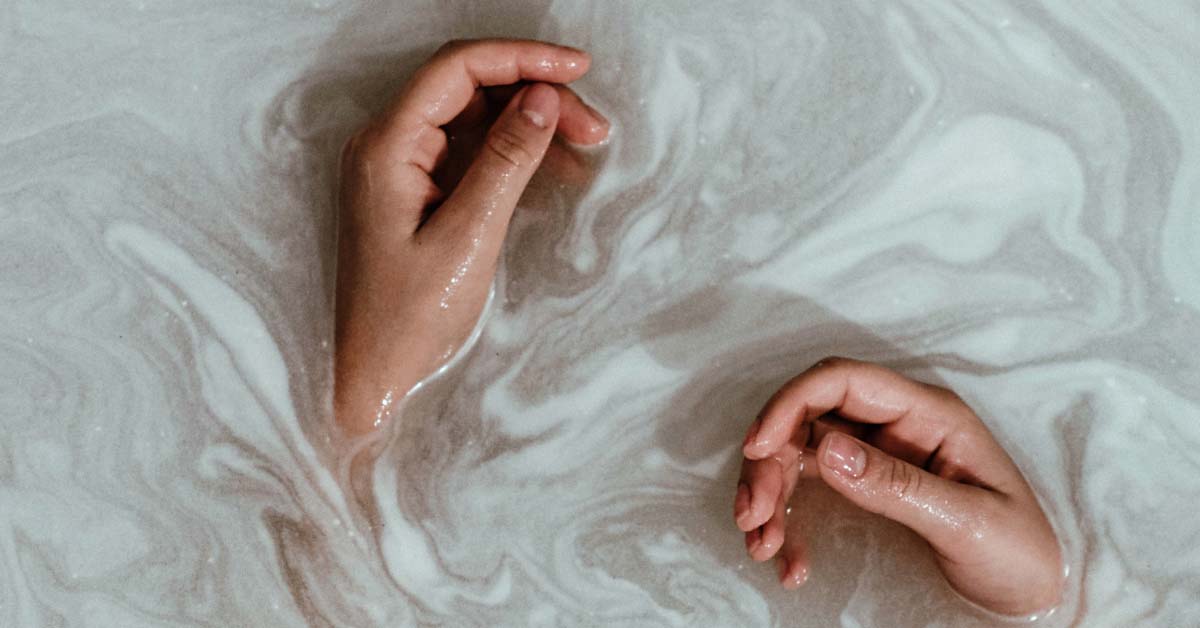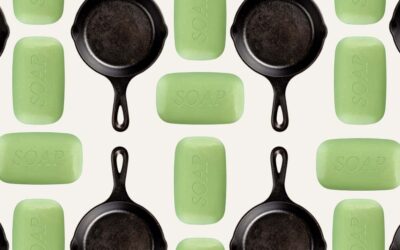Some of the craziest requests on House Hunters?
A haunted house.
An ‘adult playroom’.
A house with “no sight of planes.”
But the only thing on my must-have list? A luxurious bathtub.
In fact, my bathtub tastes bleed over into not just houses- but traveling. I never book an Airbnb without a nice bath, and -when house sitting for friends- I always come home for baths at my own home.
My love for immersing myself in the bath doesn’t just stem from my water sign status, although I’m sure it plays a role. It’s a form of ritual self care, a way to unwind after a long day.
A steaming hot bath with epsom salt and a cup of tea? There really is nothing better.
Water symbolism is rooted in renewal and rebirth- and holds a special place in most religions. Bathing also plays a powerful role in both history and artwork. If you’ve never given yourself the space to take more than a quick shower, have the belief that baths are just too cumbersome, I invite you to take a closer look.
Bathing is an art- and this article? Is the perfect place to start your masterpiece ritual.
Cleansed by Flood
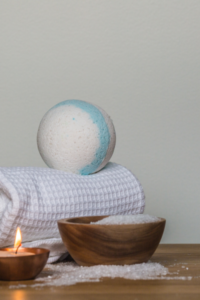 Did you know most major religions have a flood story? (Sorry Noah, but you’re not the only one.)
Did you know most major religions have a flood story? (Sorry Noah, but you’re not the only one.)
The Epic of Gilgamesh– one of the first pieces of literature recorded- talks about a great flood.
Gilgamesh meets an old man named Utnapishtim who claims he was granted immortality after surviving a great flood. Sounds familiar, right?
Aztec tribes, Buddhists, Hindus, and Nordic religions all believe in some variation of the same flood story.
Why do they all share this tale? One theory is these stories are all based on the same event. Many geologists reason a great flood happened in the Middle East at the end of the ice age.
Another theory? Water is tied to renewal, serving as the perfect catalyst for the world’s cleansing. We see this same practice mirrored by baptism in Christianity, or pilgrimage to the Ganges River in Hinduism. There’s a long held sacred belief in the cleansing power of water- a religious dedication to the art of bathing.
Actively religious or not, there’s a case to be made for bathing as a practice of renewal.
From Diana to Bathsheba- A Look at the Bathing Women
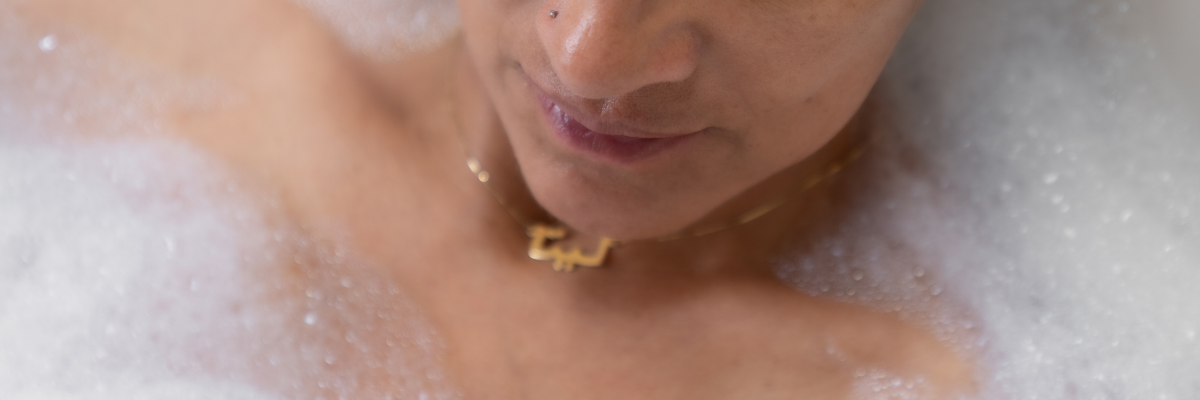
Actaeon stands at the edge of the pool, staring at her as she bathes. Slow to notice but quick to anger, the Roman Goddess Diana retaliates. She turns the hunter into a deer and immediately his trained hounds attack. Unable to cry out or command them to halt as the hounds rip into his flesh, Actaeon is torn to shreds.
At least, before dying, he gazed at true beauty- a bathing Goddess.
 This myth is a favorite of artists throughout history. One of the most notable is Rococo period artist François Boucher’s Diana Leaving the Bath. In his work he chooses a counterintuitive ‘delicate’ approach to the portrayal of the Goddess of the hunt. Instead of strong and fierce, she’s shown as the epitome of innocence.
This myth is a favorite of artists throughout history. One of the most notable is Rococo period artist François Boucher’s Diana Leaving the Bath. In his work he chooses a counterintuitive ‘delicate’ approach to the portrayal of the Goddess of the hunt. Instead of strong and fierce, she’s shown as the epitome of innocence.
But why did Boucher, and so many other famous artists, paint the mythological encounter between Diana and Actaeon?
Simple: Using this well-known myth allowed artists to explore the complexities of the nude female form without the connotation of erotica.
 Diana isn’t the only woman to be painted in the nude. Rembrandt also found inspiration in Bathsheba. In his painting, Bathsheba at her Bath, he shows the soon to be queen as David watches from afar.
Diana isn’t the only woman to be painted in the nude. Rembrandt also found inspiration in Bathsheba. In his painting, Bathsheba at her Bath, he shows the soon to be queen as David watches from afar.
Because he took his inspiration from a biblical scene, he was able to bypass church and social censorship and avoid the outcry of painting a naked woman. Ironically, many famous artists employed their lovers, mistresses, or even prostitutes as models to paint these nude scenes.
Do you recall RBH’s Creative Director writing on how boudoir photography served as a way around the social taboo of nakedness in the 1920’s? In the same way, artists’ mythological women and religiously-approved scenes bypassed the restrictions of their time- elevating bathing into the realm of high art.
The Moral Question of Bathing
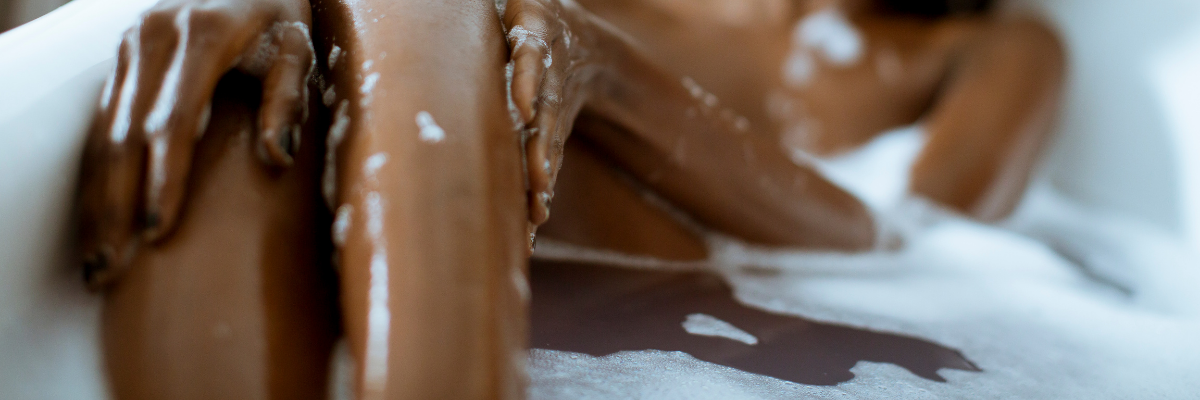
“More and more I find bathing to be less necessary,” says actor Jake Gyllenhaal in his 2021 Vanity Fair interview. Gyllenhaal is on thin ice with Taylor Swift fans…and this statement does him no favors.
The actor is one of many celebrities to swear off bathing, a trend hitting mainstream status right now. One popular argument? Bathing is selfish- and damaging to the environment.
The modern renaissance woman knows the importance of an informed perspective. Our consumption of water is worth discussing.
My roommates and I are dedicated to systems that reduce our impact on the environment. We opt for washcloths over paper towels, compost food waste, and use a bidet. We’ve torn up 1,200 sq ft of our lawn and replaced it with perennial, drought tolerant natives. We walk to the farmer’s market, thrift clothes, leave our leaves unraked in the fall for hibernating bees.
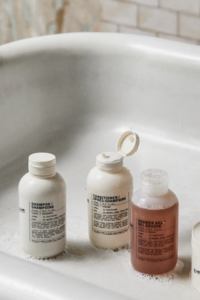 But I refuse to give up bathing.
But I refuse to give up bathing.
Why?
First, we live on the banks of the Mississippi river. We’re in the fortunate position where our water consumption isn’t affecting the direct livelihood of our neighbors.
Secondly, my water consumption doesn’t come close to the damage done by large corporations. It’s great to make changes and do our part- I agree! But part of making an environmental impact is holding the real offenders accountable.
You’ve definitely read how 100 companies are responsible for 71% of global emissions, but here’s a more applicable stat for you: In 2018, Northrop Grumman created 160.89 million pounds of water polluters.
Disgusting.
My philosophy? Cut back where necessary, but hold companies accountable above all.
And let’s get this straight:
Self care is not selfish.
And to think that bathing is selfish? Is an extension of the dangerous mindset that productivity should be the standard of self worth.
I set one night a week aside to myself. I take a bath, have an edible, and enjoy the night however I want. This time for myself helps me practice gratitude and gives me a space to just be.
So what is the perfect bath? Read on for my top three tips on how to create an indulgent experience.
3 Ways to Turn Bathing Into A Self-Care Ritual
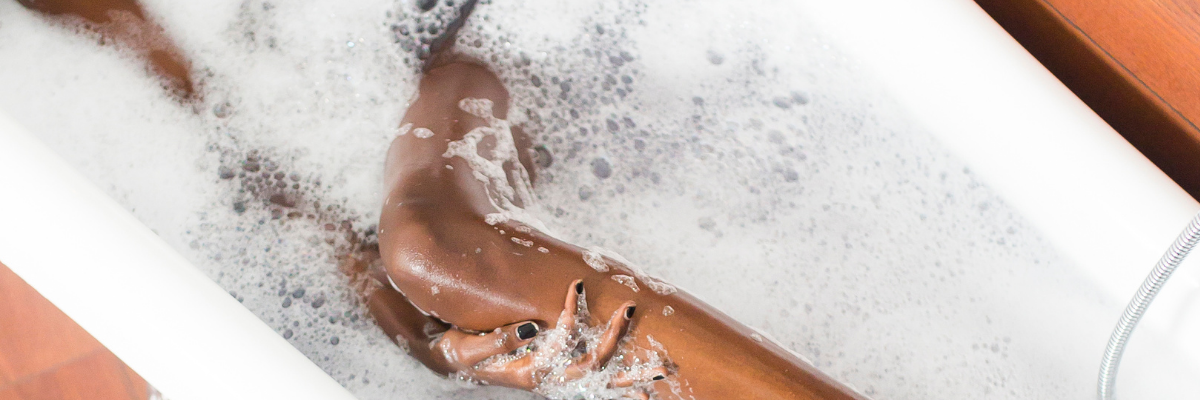
Candles, fluffy towels, a special silk robe- there are a million ways to turn an ordinary bathing experience into something extraordinary.
I have friends who always have a bud vase on their bathtub tray with fresh flowers from their garden. Others who relish wrapping themselves in a particular threadbare sweater that brings back good travel memories. And still others who have a detailed regime of soaks, oils, and creams that all have a tieback into their aromatherapy beliefs.
The point is: there’s no wrong way to bathe. The only thing necessary to make something a self-care ritual is to find ways that are luxurious to you and attach intentionality to their use. That could mean practicing a brief gratitude meditation in silence while you bathe, taking the time to truly listen to your favorite vinyl, or using scents bring back deep memories of ancestors to channel the strength of your own history.
For me? I like to keep it simple. A perfect bath has three things: a special add-in, a special drink, and a special book.
#1: Perfect Add-Ins To Elevate Your Bath
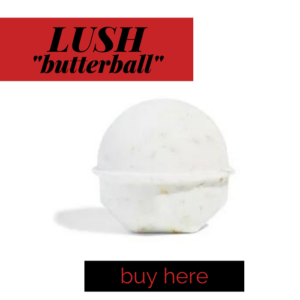 When I was 14, I was a regular visitor of urgent care. One word: UTI’s.
When I was 14, I was a regular visitor of urgent care. One word: UTI’s.
The culprit? Low quality drugstore bath bombs.
The problem is: Even an expensive bath add-in can put you at risk for infection if you aren’t careful. This is why, while I love shopping local and supporting soap makers at the farmer’s market, I’ve got two hard rules when it comes to putting anything beyond water in my bath:
- The ingredients must be all natural. No harsh chemicals or synthetic fragrances, please! If I can’t tell? I don’t buy it.
- Does it sparkle? It’s a no.
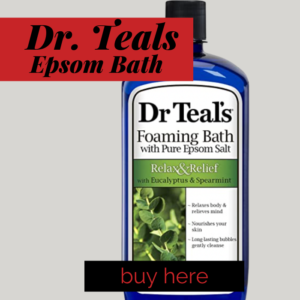 My favorite bath bombs come from Lush. Their use of all natural ingredients meets my criteria.
My favorite bath bombs come from Lush. Their use of all natural ingredients meets my criteria.
Plus the Butterball Bathbomb? It’s a must-have.
I’m also a huge fan of anything from Dr. Teal. The eucalyptus or lavender scented epsom salt? Phenomenal. Aching after a day of work? Dr. Teal’s epsom salt bubble bath is a must. It’s amazing.
#2. Set The Mood With A Drink
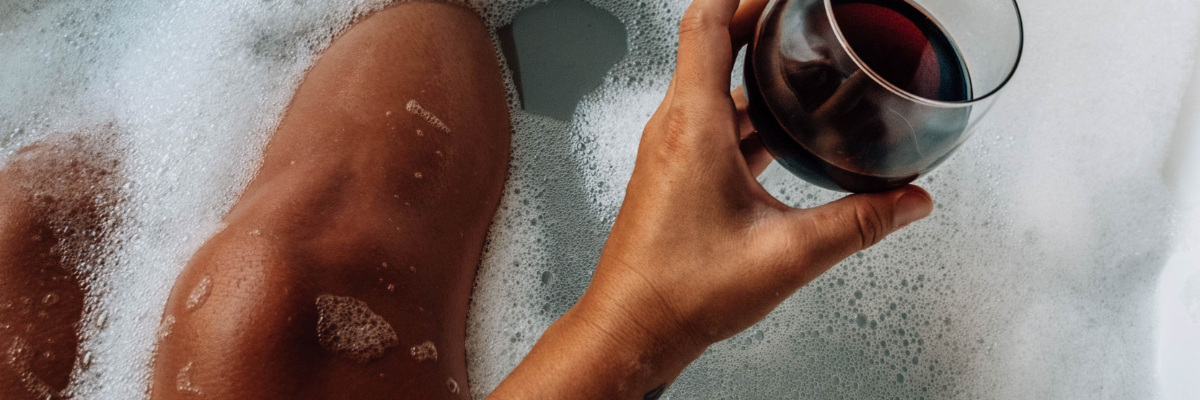
I love having something to sip on while I bathe. If it’s a weeknight, I’ll opt for Harney and Sons’ Cinnamon Tea, or the London Tea Room’s 5th of November. On Friday nights? A gin and tonic for the win!
Sparkling mineral water, infused cucumber water, or a glass of champagne work well, too. Choose something that feels luxurious to you in the moment.
If you’re going to bring a drink, I recommend purchasing a bath tray. My home bath is freestanding- but even built-in bathtubs with ledges don’t guarantee your drink won’t end up bathing with you. Plus, a bath tray allows you to remove everything from your tub you won’t be using for your experience, clearing your space and mind at the same time.
#3. Make Your Bath A Screen-Free Environment
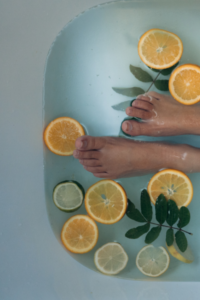 It’s fun to sit and scroll but no- not in the bath. Making your bathing ritual screen-free creates a renewing experience. Plus, dropping a book in the bath is far less stressful than your iPhone.
It’s fun to sit and scroll but no- not in the bath. Making your bathing ritual screen-free creates a renewing experience. Plus, dropping a book in the bath is far less stressful than your iPhone.
The last book I took to bath time was Andrew Morton’s Princess Diana Biography.
If you’re looking for other book recommendations, check out And They Called it Camelot, or Buzz: The Stimulating History of the Sex Toy. You can also visit our Bookshop for other great reads!
Until next time, and happy bathing,
Madeline Runyon

